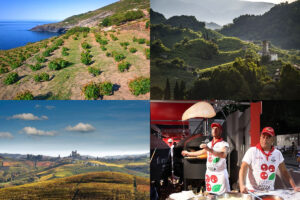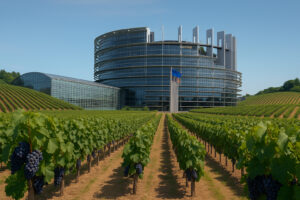According to the predictions made by the Italian Wine Union (Uiv) and Ismea, the 2006 harvest will be an important one for Italian wine, with hypotheses that 53 million hectoliters may be produced by wineries (+6% from the 50.6 million produced in 2005, and a realignment towards 2004 levels). This data is the result of a survey taken in July on vineyards located throughout Italy.
The study also predicts that 2006 is promising quality wise: the hot and dry weather pattern that has lasted until now has kept pathologies out of vineyards, and the sporadic hail storms that occurred in June don’t seem to have caused any serious negative effects. Uiv and Ismea explained, “The harvest is the fruit of a particularly favorable climate this year: in general, the winter and spring weather conditions favored exuberant vegetative growth on the entire peninsula, even though in some areas the prolonged cold slightly delayed flowering and fruit set. The vegetative delay, however, seems to have caught back up almost completely, thanks to a very hot and sunny June. Notwithstanding the prolonged absence of rain in this period, at the moment there have been no reports of particular problems with water-stressed vines. The precipitation in previous months, in fact, created a good reserve of water within the terrain. Attention, however, remains high among operators because a prolonged drought could have a negative impact on production levels, even eventually applying, where possible, emergency irrigation”.
Harvest 2006 - Region by Region
The North The Piedmont region has a fairly varied situation. From the abundant production foreseen for the provinces of Alessandria and Asti, to the slight decrease in the Cuneese area, due essentially to limited Nebbiolo production. The seasonal pruning, fertilizing, and soil working, is continuing as usual. On the plant health front, there seems to be no risk of Peronospora attacks, while flare ups of Oidio (powdery mildew) were immediately put out. There is fear, however, of drought, given that the June rains do not seem to have been sufficient enough for Piedmont area vineyards. In Lombardy, the first phenological phases were behind by 4 or 5 days, but have been completely recuperated with the help of the high temperatures in June. Fairly significant production level increases are predicted for the Valtellina area. There have been no particular adversities registered regarding grape disease attacks. Oidio has also been limited to a few flare ups that were quickly put out. There is, however, fear of drought in this area as well. Worries are that there could still result damages from the persistent heat, though June rains have been sufficient for the area. There are no forecasts for drought damage in the Veneto region either, even though experts are predicting that rainfall will actually be inferior to that of the memorably hot and dry summer of 2003. The next few weeks will be decisive. For now, the harvest appears to be abundant. The flowering was excellent, undisturbed by meteorological intemperance and damaging diseases. And it looks like the harvest will be right on schedule, with good expectations for high quality as well. In Friuli Venezia Giulia, the production process appears to have had a positive flowering period, and a vegetative development just slightly delayed due to the extended cold temperatures that lasted until the beginning of June. As for plant health, no problems have been reported. The climactic situation, however, does register a lack of water. In the Alto Adige, a slight water shortage has also been reported in some areas. Flowering and fruit set was good, both in the valley and in the hill and mountain zones. Excellent quality is predicted and a productive growth that seems more accentuated in the Alto Adige in respect to the Trentino. In Emilia Romagna, the flowering phase was perfect and the season proceeds as it should, with just a slight preoccupation for the lack of rain. There was a parasite attach in mid season, with some cases of Peronospora in the Senese area resulting in the removal of some grape bunches.
The Center Tuscany registered an anticipated productive period, with a good flowering that was partially interrupted, however, by a cold spell at the end of May and early June, but then followed by a good fruit set. In Umbria, the entire productive cycle has had above average results. The occurrence of diseases have been scarce and the climactic conditions favorable. Lazio has registered a similar situation though damage from storms at the beginning of June is still being calculated.
The vegetative cycle began a bit late but the heat in June caused the vines to recuperate. Below average interventions against funguses were made this year. The productive cycle in the Marche is considered discreet with a non uniform maturation in different areas. A Peronospora infestation was also registered at the beginning of the vegetative process. And the viticulture season in the Abruzzo area is in line with average production years though a sudden cold snap in the spring did cause a bit of difficulty in the flowering phase. In some vineyards, eradication has begun in an attempt to improve quality. Overall, the productive cycle results normal without any remarkable presence of diseases.
The South Vineyards in the Campania region are in good health, with positive prospects for the next harvest. Puglia has a vegetative state defined as lush. The flowering phase was exceptional. The abundant rains last winter and spring have left a substantial water reserve, which is indispensable for the full development during the vegetative phase of the plants. As for plant health, the biggest problems have been registered in the Salento area where there were Peronospora attacks.
The Islands In Sicily, the initial growth phases are considered good, though there is a bit of preoccupation for the early heat spells that may affect the acidity of white grapes, thus risking the quality levels.
There were a few flare ups of Peronospora among the more susceptible varieties, as well as reports of Oidio due to the winter rains. There is also preoccupation for the continued lack of rain that is a problem for the Sardinia region as well, which, other than this, has reported a positive productive cycle.
Wine Production in Italy (000 hl) in 2005
Source: Istat
Piedmont, 3,054 Val d'Aosta, 20 Lombardy, 1,100 Trentino-Alto Adige, 1,057 Veneto, 7,093 Friuli Venezia Giulia, 1,159 Liguria, 84 Emilia Romagna, 6,608 Tuscany, 2,780 Umbria, 998 Marche, 1,206 Lazio, 2,362 Abruzzo, 3,469 Molise, 390 Campania, 1,826 Puglia, 8,348 Basilicata, 267 Calabria, 539 Sicily, 7,283 Sardinia, 924 Total - 50,566
Wine Production in Italy (000 hl) from 2001 to 2005
Source: Istat
52,293 - 2001
44,604 - 2002
44,086 - 2003
53,135 - 2004
50,566 - 2005
Copyright © 2000/2025
Contatti: info@winenews.it
Seguici anche su Twitter: @WineNewsIt
Seguici anche su Facebook: @winenewsit
Questo articolo è tratto dall'archivio di WineNews - Tutti i diritti riservati - Copyright © 2000/2025








































































































































































































